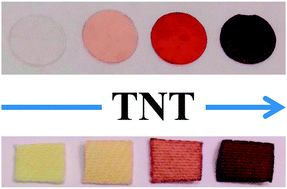Solid polymer substrates and smart fibres for the selective visual detection of TNT both in vapour and in aqueous media†
Abstract
This work describes the design of efficient, inexpensive and easily prepared selective sensory polymers with chemically anchored amine groups as 2,4,6-trinitrotoluene (TNT)-sensing motifs as materials for the selective visual detection of TNT in aqueous media and as vapours. The materials are prepared as handleable sensory films or dense membranes from which sensory discs are cut, as well as smart fibres by coating conventional and commercial cotton fabrics. Both types of material exhibited a highly visible colour development from colourless to red upon contact with TNT both in the gas phase and in solution, and the colour change was used to build titration curves using the colour definition parameters of a digital image acquired with a smartphone, i.e., the RGB system. The materials were selective, remaining silent with other nitroaromatic compounds, such as 4-nitrotoluene and 2,4-dinitrotoluene, and the detection limit in solution was close to the micromolar range.


 Please wait while we load your content...
Please wait while we load your content...